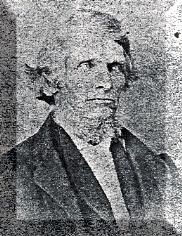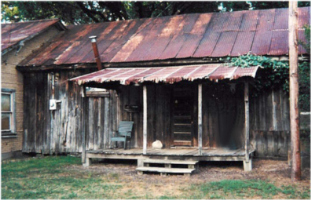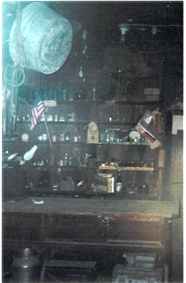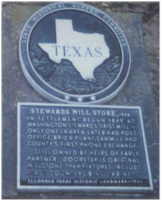GEORGE WASHING STEWARD
"Washington Steward"
THE STORE
 According
to a Texas Historical Marker, Steward’s Mill was established in 1849.
It arose around a grist mill owned and operated by Washington Steward.
The mill was the only one of its kind between Houston and the
Dallas-Sherman area and people would come and camp for several days around the
mill to await their turn to grind their corn or wheat.
The mill prospered and was converted to steam from water.
Eventually, a merchandise store was
built. Many sources say that the
mill and store were burned by northern troops during the Civil War, but more
likely it was burned by raiders shortly after the war. We know that the mill was
rebuilt as soon as possible. Washington continued to manage the mill until
his death, when his son, Jeremiah Terry Steward took over the operation. (Photo
copied from "The History of Freestone County Texas").
According
to a Texas Historical Marker, Steward’s Mill was established in 1849.
It arose around a grist mill owned and operated by Washington Steward.
The mill was the only one of its kind between Houston and the
Dallas-Sherman area and people would come and camp for several days around the
mill to await their turn to grind their corn or wheat.
The mill prospered and was converted to steam from water.
Eventually, a merchandise store was
built. Many sources say that the
mill and store were burned by northern troops during the Civil War, but more
likely it was burned by raiders shortly after the war. We know that the mill was
rebuilt as soon as possible. Washington continued to manage the mill until
his death, when his son, Jeremiah Terry Steward took over the operation. (Photo
copied from "The History of Freestone County Texas").
 It
is suspected that some type of mercantile operation
existed before the Civil War - perhaps as part of the mill. Many sources
refer to the "rebuilding" of the store in 1867. I've found no
proof of a former store, but given the stories about folks camping out awaiting
their turn to get their corn or wheat ground, it seems likely that an
enterprising man like Washington would have some merchandise available. We do know that in
1867, a store was built by
Washington, his son Jeremiah T. Steward and Dr. James Bonner as partners.
Lumber was brought up the Trinity River to Troy by boat and then overland by ox cart.
The cost of the new building was $588.20 and an addition was built in
1875 with a cost of $726.20. (Side entrance to the store,
photo taken 2001) Frank & Dorothy Bragg, one time-owners of
the store, added a small living area consisting of 1 bedroom, a bath,
combination living room/kitchen and a half-basement under the living quarters
for storage. The addition is visible in the far left side of this
picture. The store is currently owned by Bonner descendents
(2002).
It
is suspected that some type of mercantile operation
existed before the Civil War - perhaps as part of the mill. Many sources
refer to the "rebuilding" of the store in 1867. I've found no
proof of a former store, but given the stories about folks camping out awaiting
their turn to get their corn or wheat ground, it seems likely that an
enterprising man like Washington would have some merchandise available. We do know that in
1867, a store was built by
Washington, his son Jeremiah T. Steward and Dr. James Bonner as partners.
Lumber was brought up the Trinity River to Troy by boat and then overland by ox cart.
The cost of the new building was $588.20 and an addition was built in
1875 with a cost of $726.20. (Side entrance to the store,
photo taken 2001) Frank & Dorothy Bragg, one time-owners of
the store, added a small living area consisting of 1 bedroom, a bath,
combination living room/kitchen and a half-basement under the living quarters
for storage. The addition is visible in the far left side of this
picture. The store is currently owned by Bonner descendents
(2002).

Some of the merchandise in the store was brought overland from Galveston and some came by way of the river. Cotton was the cargo on the return trip. The store also served as a bank and liquor store. Original counters, cabinets and some original merchandise still remain in the store today. (Inside the store, Photo taken 2001)

Sam Houston Graves (a grandson 3 times removed) and his wife Laurie Jeanne Karnes Graves are checking out the store in this picture. (Front entrance of the store, photo taken 1987) According to another descendent, Jo Watson Turner, the little room on the back of the store (far right in this picture) was used as the office and also stored the safe. There is a fireplace in this room on the back wall.
Many of the store ledgers still exist today and are currently housed in the Fairfield County Museum. The ledgers are very detailed and contain pages for each person’s account with the store, recording charges, what items were charged, and payments made on accounts. I have read many of the accounts for our ancestor Francis (Frank) Marion Steward, SR (one of Washington's sons). Much about an ancestor can be gleaned from these ledgers. We know he infrequently bought alcohol, but did buy a lot of tobacco. He bought violin strings often - did he play the violin? We see when he started courting our Annie Eliza Cain. He buys expensive new clothes, starts drawing frequent amounts of cash, and buys perfume. Shortly after, we see entries for "ribbons for wife", yards of calico, and other "merchandise for wife". We know that he built a new house for his wife and for a period large amounts of building materials are purchased.
A sample of accounts for Francis in 1871 is:
6-May
5.40 1 pair boots & socks
19-May 0.75 3 yds fine bleached domestic @ .25 yard
10-Jun 1.35
Tobacco & violin strings
12-Jun 0.75
1 mill saw file
26-Jun 0.50
Balance on the brandy
11-Jul 0.75
1 file
Postal service was added to the store on 26 Nov 1872, with Washington's son, Jeremiah Terry Steward, being named postmaster. That post office operated until 1914. Prior to that time, the small community was know as Steward's Mill. The post office changed it to Stewards Mill (taking out the apostrophe).

There is one very unique feature of the store. On the walls of the side porch, extreme weather was recorded on the wall in pencil along with a few interesting comments when the weather got really cold. A few examples are: (Close-up of writing, Photo taken 2001)
High Temperatures: Low Temperatures:
31 Jul 1893 109 degrees -2 degrees March 18, 1892
12 Sep 1893 105 degrees May 1, 1905 Began sleeting,
everything covered.
9 Aug 1907 111 degrees September 3, 1932 Creaks all dry.
17 Aug 1917 - 109 degrees September 4, 1932 Dam cow
drowned.
Water 30 ft. deep-over top of fence. "20 rain.
I often wondered who started the tradition of writing the temperatures on the wall of the store, but while recently reviewing a copy of George Washington Steward's family bible, there are two entries as follows:
"A killing frost the 15th of Aprile 1849"
"A killing frost the sixth of Aprile 1857 deep snow on the 12 same date".
So, I suspect that old Washington himself started the writing of extreme weather on the store walls and the tradition was carried on my subsequent owners.
In 1964, Texas State identified the store as a historic landmark. (Photo taken 2001) The inscription reads:

STEWARDS MILL STORE
In settlement begun 1849 at Washington Steward’s Gristmill-Only one in area.
Later had Post Office, Brick Plant, Sawmill and County’s First Phone Exchange
Still Owned by heirs of early partner. Doorstep is original millstone.
1964 fixtures include first counters, bins, cabinet.
